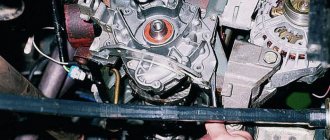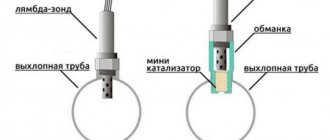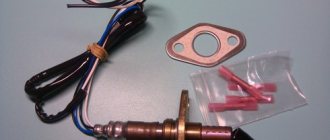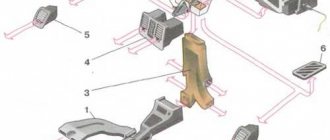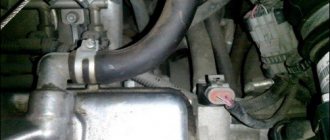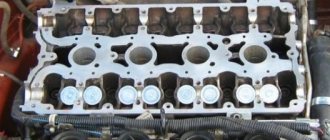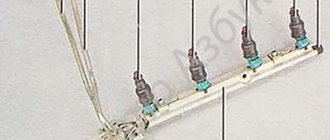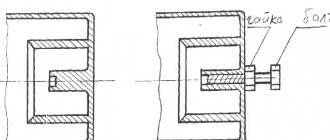What is an engine breather and why is it needed?
Everyone knows that the internal combustion engine, the same one that is installed under the hood of your car, does not run on gasoline, diesel or gas, but on their mixture with air. Moreover, it is air, which costs nothing (unlike fuel, for which we regularly pay a tidy sum at the gas station), that is required many times more. But in addition to the influx of clean air and the removal of exhaust gases through the exhaust pipe, parasitic gases are formed during the operation of the internal combustion engine.
A breather is nothing more than a breathing valve that constantly relieves excess pressure that forms inside the engine during operation. The need for this simple, relatively inexpensive part is difficult to overestimate.
INSPECTION AND CLEANING OF THE VENTILATION SYSTEM
On the VAZ-2110 this is done like this:
1. Disconnect the pipes from the breather, valve cover, air pipe and check the degree of clogging. If necessary, they can be washed in gasoline or kerosene and then dried;
2. Unscrew the nuts securing the valve cover and remove it. On the inside there are two bolts securing the oil separator roof, which must be unscrewed;
Source
Where is the engine breather located?
From engine to engine, different car manufacturers may place the breather in different places. But in most cases it is located on the valve cover, next to the filler neck. Although there may be options: it is better to clarify in the description instructions for the car or find out on thematic forums.
In the picture on the right is the crankcase ventilation system of the VAZ 2111 engine, which includes a breather:
- Crankcase.
- Breather.
- Hose from the breather to the valve cover pipe.
- Oil separator under the valve cover.
- A thin hose from the valve cover to the fitting with the throttle body nozzle.
- Fitting with jet on the throttle valve block.
- Thick hose from the valve cover to the intake pipe..
But the breather is installed not only in internal combustion engines. It is in:
- Gearbox. Otherwise, the gearbox would begin to operate jerkily, and the wear of the gears on the secondary shaft would increase many times over. Something similar is observed when the breather becomes clogged and ceases to perform its function.
- If the design of the car provides for a separate transfer case, then a similar mechanism may be in it.
- Front, and in rear-/all-wheel drive vehicles - in the rear axle. Moreover, this inconspicuous detail not only equalizes pressure, it protects the mechanisms from dirt and moisture when overcoming water obstacles.
However, even their appearance is often similar, and often identical: they perform the same function.
How to clean the crankcase ventilation system on a VAZ 2110-VAZ 2112?
The note! Before starting work, remove the air filter housing, as this will greatly interfere, if you do not know how to do this, then read the article entitled: “Replacing the air filter housing by tens”!
Remove: 1) The most difficult thing is to remove the cylinder head cover and the rest of the parts associated with the ventilation system (mainly hoses), the easiest way to remove it is, in general, we will start by first disconnecting the wires from each other, namely the top connectors (see Photo 1) and bottom connectors (marked with a red arrow), once this is done, remove the connectors, to do this, squeeze the two latches on one connector with your fingers and remove it (see Photo 2) and do the same with the other connector, just without removing them, they will get in the way, and indeed, you cannot remove the cylinder head cover without removing these connectors, because the wires simply will not allow you to do this, both connectors were on the brackets, so unscrew the bolts and remove both brackets from the cylinder head cover, for more information on how to do this, see Photos 3 and 4 below.
2) Now remove the exhaust manifold from the cylinder head cover, it will be secured with bolts, and by the way, when removing it, replace all the rings, firstly, they are not expensive, and secondly, after replacing it you will be 100% sure , that the collector will not let air through anywhere, because the new ones will stand, you can read more about how to do this in the article entitled: “Replacing the receiver on a car with 16 valves.”
READ Which head is suitable for VAZ 2103
3) Then start removing the hoses, they hold the clamps, the clamps are unscrewed with a screwdriver or nuts, if it is inconvenient to work with a screwdriver, all the clamps that need to be loosened, and all the hoses that you need to remove, you can see in the photos below:
The note! Wash the removed hoses with gasoline or kerosene, then dry them in the sun and, if possible, blow them with compressed air (for example), before installing, make sure the hoses are dry, if necessary, wipe them with a rag and wipe them dry. By the way, also thoroughly clean all the places where the hoses are connected with a rag and remove all dirt from them!
4) When everything is done, remove the cover from the cylinder head, it is secured with fifteen bolts, these bolts are unscrewed using a hex key or socket wrench head and an "8" screwdriver, then the screwdriver is disconnected from the cylinder head and removing it from the machine is most convenient separate it from the cylinder head in those places where there are special protrusions for this purpose, one of such protrusions is marked with a blue arrow.
5) Once you have the cylinder head cover in your hands, use a wrench or cap to remove the six bolts that secure the cage to it (the large photo shows several bolts) and remove it from the cover (see small photo). ,
Installation: All parts are installed in the reverse order of removal, but before installation, rinse thoroughly with gasoline or kerosene, this applies to the cylinder head cover itself, there should be no dirt on it, and clean the surface on which the old sealant was located (screwdriver or grainy leather) installed . Cylinder head cover, after removing, degrease it and apply new sealant, as shown in the small photo below:
Additional Video: An interesting video that will give you a little more information about the crankcase ventilation system is located below:
Source
Breather device
Typically, the internal structure of the breather is very simple. Let's look at it using the example of a breather for a gearbox/axle.
- External breather housing. It is made of metal, so it cannot be damaged while driving.
- Pressure spring. Thanks to it, the mechanism does not need an electrical/mechanical drive, everything is autonomous.
- Rubber gasket. It is this that ensures tightness when excess pressure is not released.
- Lock nut. The simplest method of fixation: although in other models there are a variety of options.
- The breather body itself. The through hole allows the unit to “breathe”, relieving excess pressure.
Although this breather is not used for engines, the principle is the same. An elementary module that you simply cannot do without.
Why is there smoke coming from the breather?
There can be only one malfunction of the breather: it began to poorly pass accumulated gases, comparing the pressure inside the engine with atmospheric pressure. But the smoke coming from it can say a lot:
- The cylinder oil scraper rings were stuck or worn out. Simple decarbonization using traditional methods or special chemicals will not help here, so you will have to disassemble the engine.
- Likewise, if one/several exhaust valves burn out. A simple compression test will help determine this.
- Oil seals. Just replace them when it's time or they show signs of increased wear.
- The shaft seals, which allowed oil vapors to pass through, were worn out. Change them without hesitation, preferably without shelving them.
- The oil in the engine is old and needs replacing for a long time. No comments: as practice shows, repairing the “heart” of a car is tens of times more expensive than replacing it.
- White smoke on a hot engine - coolant enters the lubrication system. You'll have to look for where exactly the leak is.
- Oil overflow. In an internal combustion engine, it is just as dangerous as underfilling: engine wear/fuel consumption increases significantly, so check its level with a dipstick on a level surface when the engine is well warmed up. Then you will see how well the technicians at the service station (or you yourself) performed its replacement/topping up.
- The oil is of poor quality/not suitable for the car/counterfeit. There is only one way out - replace it. Likewise, if you filled up with fuel at an unknown gas station: just don’t do it again.
- Finally, the breather itself clogged from time to time, not working at 100%. Simple cleaning and preventive maintenance will eliminate this.
Breather repair and maintenance
Due to its low cost, as well as ease of removal/installation, breather repair almost always comes down to replacing it. But even forgetful car owners who carry out its maintenance from time to time will not need this, since there is simply nothing to break.
All its maintenance comes down to timely cleaning. It is enough to wipe the outside with a rag, and if the stains are old, you will have to use a knife, screwdriver or scraper.
Cleaning the inside is a little more difficult, but still very simple. The breather must be removed (it can be bolted or firmly seated “in tension”) and cleaned with a primitive cleaning rod, which can be made from a piece of wire. We do the same with the oil trap mesh: in rare cases, when it is very clogged, mechanical cleaning will not be enough. And then you need to burn it by pouring just a little gasoline, or soak it in aggressive chemicals for several hours.
Assembly, as is quite predictable, is in reverse order. Therefore, the entire process will not take much time and will not require special tools or skills.
However, this is best done during a seasonal oil change or when undergoing regular maintenance. On most cars with average mileage, it is enough to carry out this simple operation twice a year. But it is the engine breather that confirms the immutable truth: there are no small details in a car, especially a modern one.
What is an engine breather and why is it even needed? Here's the question"
What is an engine breather and why is it even needed? Here's the question
This can save you from more expensive repairs. In fact, the breather, although it seems like an insignificant detail, in practice is of great importance for the health of the power unit.
What is an engine breather?
Before answering this question, it is important to understand what it is intended for. This is directly related to the principle of its operation. The main task of this device is to reduce the pressure in the engine crankcase. When the power unit operates, various gases collect in the crankcase. Gradually they accumulate and create quite a lot of pressure. If you do not bleed them, the engine may stop, the pressure will back up the pistons. In this case, the gas will seek an exit through any available hole. To prevent this from happening, a breather is installed.
This also happens with the help of this device. Unnecessary gases are removed from it. Thus, the temperature inside the engine is slightly reduced. The engine breather has two tasks: ventilation and releasing excess pressure. In some cases, the operation of the breather can indicate the presence of problems in the engine. or damage to the piston, gray smoke characteristic of the exhaust will fly out of the hose. This way you can diagnose these faults without disassembling the engine. In normal condition, a slightly noticeable transparent smoke comes out of the breather.
The breather is essentially a valve that bleeds air from the engine. As the pressure increases, it begins to allow a certain amount of gases to pass through it. The greater the pressure, the more air can pass through it. To prevent atmospheric air from entering inside, the valve is capable of flowing only in one direction. But on some cars this process is reciprocal. In such versions, a filter is installed in the valve to prevent dust from getting inside the motor.
Most often, the breather is located next to the oil filler neck. Much less often you can find options with its location on the side of the cylinder block. From the outlet pipe there is a hose connected to the air filter housing. This arrangement is typical for all cars. It may differ only in small nuances due to the characteristics of the body. Sometimes there are 2 pipes, in which case the second hose is connected to the injector.
breather VAZ 2112 16 valves - hello. thank you very much. I have a VAZ 2112 - 22 answers
In the Service, Maintenance, Tuning section, hello to the question. thank you very much. I have a VAZ 2112 asked by the author Ask for the best answer It may have overheated and the rings are stuck.
Reply from 22 replies[guru] Hello! Here is a selection of topics with answers to your question: Hello. thank you very much. I have a VAZ 2112 Answer from Alexander Sudorgin [guru] poured oil Answer from Eurovision [guru] Valve drive parts are attached to the upper plane of the head, which are covered with a lid with a cap. A breather is mounted on the cap. It communicates the crankcase cavity with the atmosphere. The breather is necessary to prevent oil from being squeezed out through the crankcase seals by gases penetrating from the cylinders. Air and gases that have escaped from the cylinders into the crankcase come out through the breather. If, after stopping the engine, the pressure of the cooled air in it becomes below atmospheric pressure, the air enters the crankcase from the outside through the breather. Wire packing soaked in oil cleans the air of dust. In some engines, the breather is located on the side wall of the block (from the side of the rod chamber) or in the neck cover for pouring oil into the crankcase. Most car engines have forced crankcase ventilation. A pan is attached to the bottom plane of the crankcase, which serves as a reservoir. In general, check the oil level)) Answer from Ashera? [guru] Is this when they started installing the Priora engine on the VAZ 2112? 16 valves does not mean at all that it is a Priora one. And how did you notice this oil? The breather drives gases into the spider and not into the air vents. There are 2 breathers. Which one does it drive from? Most likely, the partition between the rings on one cylinder has burst. Answer from theosophy [guru] Check the crankcase ventilation system, there should be a primitive oil separator, so check it first of all with engine diagrams on the Internet, so start by studying the hardware.
Source
Crankcase VENTILATION SYSTEM
The power plant of any car is a very complex device, including mechanisms and systems that interact with each other. At the same time, the engine is not a closed hermetically sealed circuit and it also has ventilation. Crankcase ventilation is a scheme that ensures the removal of gases from internal cavities. The fact is that during combustion of the working mixture in the cylinders, exhaust gases are formed, which are under pressure, due to which part of them penetrates into the sub-piston space - the crankcase, where it mixes with oil mist and moisture formed as a result of condensation. This whole mixture is called crankcase gases. If the engine were sealed, with an increase in the amount of gases in the crankcase, the pressure inside it also increased. Because of this, a breakthrough of gases along with oil through the breather, oil seals, seals or the hole in the oil dipstick is possible. Based on this, it follows that the main task of the ventilation system is to maintain pressure inside the engine and prevent it from exceeding the permissible norm by removing crankcase gases.
Video: How to Clean the Breather VAZ 2110 16cl
Result:
What is the crankcase ventilation system made of? From the hoses, from the oil separator, from the oil separator, all these parts can be seen in the diagram below, all of this gets dirty over time, so it is necessary to dismantle the crankcase ventilation system from time to time and clean it of dirt. And the oil is inside, then the engine will work normally, and all the dirt that is in the ventilation system will not enter the engine for re-combustion, but for engines that have traveled quite a lot (200 thousand km and above), we simply recommend putting this system in a bottle so that it does not choke the engine in the car, and it drives more or less, and in order to ensure ventilation of the crankcase in the bottle, you need a screwdriver and a suitable (small) one. For information on how to do this, see the video. located at the end of the article, where everything is shown in detail.
READ How to Check Air Flow Meter with Tester
When should I clean the crankcase ventilation system? It all depends on how well the engine is running, if the piston rings are worn and it is constantly throwing oil into the crankcase vent it will need to be cleaned much more often, unlike a new or empty engine it is easy to clean these engines need a vent system every 40,000 thousand km Approximately (you need to clean it before changing the oil), you can more often if you have free time, it will not deteriorate, but a very dirty crankcase ventilation will make it difficult for gases to drain from the crankcase into the cylinders, so the gas pressure inside the engine will increase the gas, there is simply nowhere to go apply, except for other types of seals that come out through the seals, due to which oil will flow through the seals (mainly due to dirty crankcase ventilation. Oil begins to flow through the front crankshaft seal).
VENTILATION DESIGN FEATURES, OPERATING PRINCIPLE
The simplest diagram of the crankcase ventilation system used on internal combustion engines previously consisted of only one fitting - a breather installed in the crankcase. This breather connected the internal cavity of the cylinder block with the external environment, and crankcase gases simply escaped through it into the atmosphere. But this scheme had one significant drawback - the exhaust gases contained oil particles, which also entered the external environment. And this is not only loss of lubricant and the need for periodic refilling, but also air pollution. On modern cars the ventilation system is closed. It also has a breather, but a pipe is connected to it, allowing gases to be vented into the intake manifold or air filter housing, from where they enter the cylinders and burn. That is, the atmosphere is not polluted by them. Additionally, the system includes elements that ensure oil separation and return back to the crankcase so that it does not enter the cylinders along with the gases.
There are several options for oil separators, and on cars from different manufacturers they may differ in design and operating principle. It is worth noting that part of the exhaust gases enters the supra-valve space, and they must also be removed. Therefore, the entire circuit of the engine ventilation system on a modern car consists of a breather, an oil separator and two pipes. Additionally, a special valve can be included in the system to regulate the pressure of gases entering the intake manifold. The configuration of the system can be very different, but this does not change its purpose and operating principle. For example, consider the ventilation design of the VAZ-2110. At the bottom of the cylinder block of this car there is a breather, onto which a pipe is attached; the second end of this hose is connected through a fitting to the cylinder head cover. At the same time, an oil separator is located inside this cover at the inlet of the pipe. On its other side there is another fitting, to which a tube is connected that goes to the air inlet pipe.
The principle of operation of such ventilation is simple - gases enter the cylinder head cover space through the breather and pass through the oil separator, while the separated oil flows to the valve assembly. After this, the gases are mixed with those that have broken into the supra-valve space and are supplied to the air pipe, and then to the manifold. There is no pressure regulating valve in this car. On other machines, the oil separator may be located immediately next to the breather, and a valve is installed behind it.
Why does oil get into the air filter on a VAZ-2112 16 valves
Many people probably remember how oil appeared in the air filter in old carburetor cars. A lot has changed since then - the injection system, more electronics and safety. But the reasons for this effect remained almost unchanged. In this article, we will look at the reasons for the appearance of oil in the air filter of the 16-valve VAZ-2112.
Reasons for the appearance of oil in the air filter and its housing
Air filter that has absorbed oil
If we take the normal condition of the car, then the air filter must be dry throughout its entire service life. But the presence of oil indicates that there are problems in the mechanical part of the engine. Therefore, we will not consider problems in the electronic control unit, since this part has nothing to do with it in this case. So, let's look at the reasons for this effect:
- Compression.
- Adjustment of valves.
- Crankcase ventilation.
- Additives.
- Catalyst.
Once the causes have been considered, you can move directly to methods for solving problems, in the order in which they might occur.
Solution methods
The main reason where the problems lie is the valve stem seals. It is through them that the oil enters the pipe, which squeezes the lubricant onto the filter. First of all, it is necessary to replace this particular element. Of course, there are quite a lot of reasons besides valve seals, so it is necessary to dwell on each separately.
REASONS FOR OIL EMISSION THROUGH THE BREATH.
But there are many of them, and many of them do not relate to ventilation.
Lubricant may flow through this system due to:
1. Severe wear of the piston rings and the cylinder-piston group as a whole. Because of this, a very large amount of gases break into the crankcase, and the ventilation simply does not have time to remove them all. Therefore, increased pressure is formed inside the engine, which squeezes oil into the breather;
2. Clogged oil separator drain channel. In this case, the separated oil has nowhere to go, and it is mixed into the passing gases;
3. Air filter dirty. The engine sucks in a large amount of air, and if there is not enough air due to a clogged element, the motor will suck it in along with oil from the ventilation system;
4. Increased amount of oil in the system. If there is more lubricant in the engine than normal, then excess lubricant will enter the ventilation;
5. Jamming of the ventilation system valve;
6. Timing belt wear or valve burnout. As a result, crankcase gases enter the above-valve space, then they penetrate into the crankcase, significantly increasing the pressure.
DIAGNOSING THE CAUSE OF OIL RUSSIAN
Since there are a large number of reasons for oil leaking through the breather, a comprehensive check of the engine is necessary to determine exactly why the problem arose. At the same time, to carry it out, you don’t even need to disassemble the power plant, it’s just enough to take measurements of some parameters, as well as visually assess the condition of the ventilation. For example, let's take the already mentioned VAZ-2110. Let's assume that in the engine of this car, plaque and oil deposits were noticed in the intake manifold, which indicates oil leakage through the breather.
To determine what caused this problem, you will need little - a set of open-end wrenches, a screwdriver, a compression gauge. We'll start the test by assessing the exhaust gases. To do this, just start the engine and look at their color shade. If it is gray or black in color, this indicates oil getting into the cylinders due to wear or sticking of the CPG rings or problems with the timing belt. Only this can help determine the cause; read more here - the causes of smoke from the exhaust pipe. It is also necessary to check the compression in all cylinders. In the normal state of the cylinder-piston group, it should be in the range of 11-13 MPa. The difference between the readings in the cylinders is allowed to be no more than 1 MPa.
If the compression in one cylinder is significantly lower, it can cause oil leakage. But why exactly this is happening - rings or valves - can be determined by the spark plug that was installed on this cylinder. Heavy carbon deposits on it will indicate a problem with the CPG.
But if the compression is low, and the spark plug has a normal working appearance without carbon deposits, you should check the valves. If the compression in all cylinders is normal, we proceed to inspect the elements of the ventilation system.

